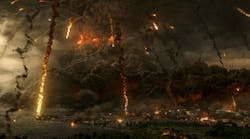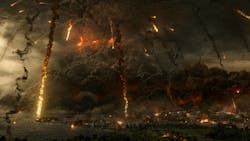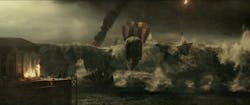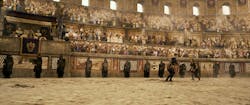From notes on the movie:
“Pompeii tells the epic story of Milo (Kit Harington), a slave turned invincible gladiator who finds himself in a race against time to save his true love, Cassia (Emily Browning), the beautiful daughter of a wealthy merchant who has been unwillingly betrothed to a corrupt Roman Senator. As Mount Vesuvius erupts in a torrent of blazing lava, Milo must fight his way out of the arena in order to save his beloved as the once magnificent Pompeii crumbles around him.”
I am actually looking forward to seeing the movie but it will be even more fascinating to me since I was able to speak with Dennis Berardi, founder of the Mr. X studio and Visual Effects Supervisor for Pompeii. I found out about how Dennis and Mr. X were able to work with director Paul W.S. Anderson to electronically recreate not only the city of Pompeii, in great detail, but also the physics of the disasters that took place surrounding the event including the tidal waves and final eruption of Mount Vesuvius.
Related Articles
- RoboCop Returns With An Eye On Realism
- Spider-Man Swings Through A Virtual 3D World
- Technologies Combine For Low-Cost Motion Capture VFX
- Prometheus Takes Flight With Cutting-Edge VFX Technology
- The Wireless 3D Hobbit
Berardi and Anderson wanted a stylized but accurate look. The film is historically accurate in its setting while adding the narrative that most people will enjoy. A significant amount of effort went into mapping Pompeii so it could be recreated digitally for the various scenes. Of course, the director does take some liberties in bending the map for some things like the quintessential chase scene that starts in the amphitheater, runs through the streets past some imposing architecture and ends in the forum. It is impressive but it does not quite get from point A to point B using the real map. It is a minor quibble compared to the other technical aspects that are more rigorous.
In particular, Mr. X developed a range of custom simulations to address details like pyroclastic flow from Mount Vesuvius, the tidal wave and even how the cloth sails react because all of this is rendered digitally. It would have been a bit more expensive to recreate the real volcanic eruption and miniatures do not really work for in this instance.
Mr. X did quite a bit of research, both historical and technical, into volcanic eruptions. It turns out that there was very little lava flow with Mount Vesuvius but there was a lot of high temperature ash. The volcano does eventually blow its top. It goes up, comes down and pushes the ash out and over everything.
The results of the ash are highlighted at the beginning and end of the movie where you see what appears to be fossils of people caught in the event. What actually happened was a bit more interesting. The ash essentially vaporized what every it landed on but left a cavity in its place. Archaeologist eventually discovered these cavities but it was not until someone filled one with plaster and looked at the result that they found out why these cavities were so common. It essentially captured the last minutes of life from people to animals. The images in the film are digital recreations.
One surprising detail that came from their research was the amount of lightning associated with volcanic eruption. Another detail is the pumice ejected from the volcano. So those effects on screen are not just for drama but what actually happened. Some of this research was done by looking at movies from more recent eruptions like that of Mount St. Helens.
For the tidal wave (Fig. 2), the people at Mr. X had to address the variety of ships. This is actually more difficult than the city although the number of elements is smaller because of the complexity of movement on the water. The sails also needed simulation and this turned out to be useful in other aspects of the film because sail technology, including rigging, was used throughout the city for providing shade. Not only did Mr. X have to come up with cloth movement but they also had to handle cloth when it was on fire. This attention to detail helps highlight the massive level of destruction that takes place in the film.
The use of quite a bit of green screen filming allowed Anderson to have a massive background while implementing a fraction of it. About 30% of shots like the amphitheater, forum and temples are real artifacts (Fig. 3).
About 130 feet of one side of a street were use for many scenes. The other side of the street was sometimes recreated digitally depending upon the camera angle.
Right now I have to cut this short so I can go see the movie. I'll let you know about more details and what I think when I get back.




